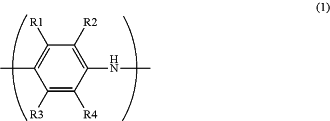| CPC G03F 7/11 (2013.01) [C08G 73/0266 (2013.01); C08K 5/098 (2013.01); C08K 5/19 (2013.01); C09D 5/24 (2013.01); C09D 179/02 (2013.01); G03F 7/20 (2013.01); G03F 7/327 (2013.01)] | 11 Claims |
|
1. A conductive polymer composition comprising:
(A) a polyaniline-based conductive polymer having at least one kind or more of a repeating unit represented by the following general formula (1):
 wherein, R1 to R4 each independently represent a hydrogen atom, an acidic group, a hydroxyl group, a nitro group, a halogen atom, a linear or branched alkyl group having 1 to 24 carbon atoms, a linear, branched or cyclic hydrocarbon group having 1 to 24 carbon atoms containing a hetero atom, or a linear, branched or cyclic hydrocarbon group having 1 to 24 carbon atoms partially substituted with a halogen atom,
(B) a carboxylic acid salt represented by the following general formula (2):
 wherein:
L represents a single bond or a linear, branched or cyclic saturated or unsaturated hydrocarbon chain having 1 to 8 carbon atoms in which a hetero atom may be interposed, when L is a single bond, then n=0 and when L is not a single bond, then n=1;
R5 and R6 each independently represent a hydrogen atom, a hetero atom, a —COO−X+ group, a hydroxyl group, a linear, branched or cyclic monovalent hydrocarbon group having 1 to 20 carbon atoms in which a hetero atom may be interposed, or a linear, branched or cyclic saturated or unsaturated hydrocarbon group having 1 to 8 carbon atoms having a —COO−X+ group at the end thereof;
R7 represents a hydrogen atom, a hydroxyl group or a —COO−X+ group; and
X+ represents a lithium ion, a sodium ion, a potassium ion or a nitrogen compound represented by the following general formula (3):
 wherein, R101, R102, R103 and R104 each independently represent a hydrogen atom, a linear, branched or cyclic alkyl group, an alkenyl group, an oxoalkyl group or an oxoalkenyl group each having 1 to 12 carbon atoms, an aryl group having 6 to 20 carbon atoms, or an aralkyl group or an aryloxoalkyl group each having 7 to 12 carbon atoms, and a part or whole of the hydrogen atoms of these groups may be substituted by an alkoxy group; R101 and R102, or R101, R102 and R104 may form a ring, and when a ring is formed, R101 and R102, and R101, R102 and R104 each represent an alkylene group having 3 to 10 carbon atoms or a heteroaromatic ring having the nitrogen atom in the formula in the ring, and
(D) a water-soluble polymer,
wherein a content of the Component (B) is 1 part by mass to 70 parts by mass based on 100 parts by mass of the Component (A).
|